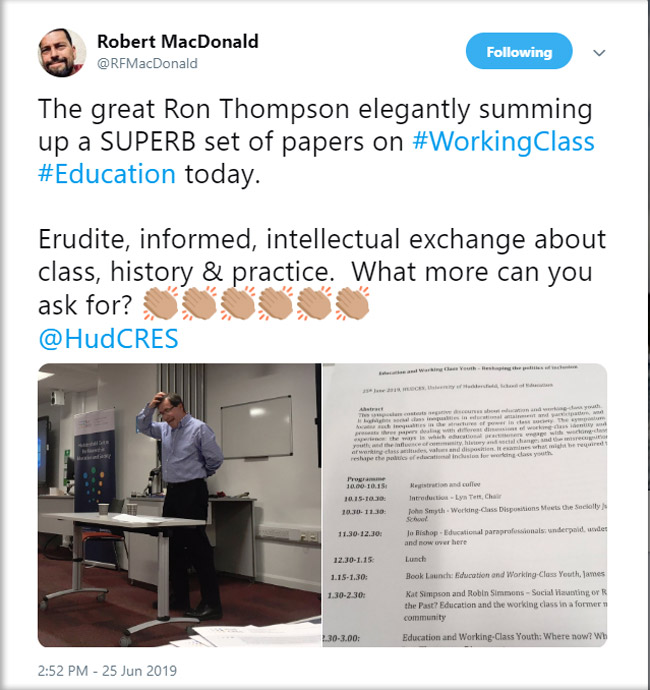
Dr Ron Thompson
HudCRES
Although social class has famously been dismissed as a ‘zombie category’ with little value for understanding contemporary patterns of inequality, the last few years have seen a resurgence of interest in class in education. Recent work in this area includes Diane Reay's deeply personal indictment of provision for the working class in her book Miseducation, statistical analyses such as Social Mobility and Education in Britain by Erszebet Bukodi and John Goldthorpe, and my own recent book Education, Inequality and Social Class.
Another major contribution to the field is the edited collection Education and Working Class Youth, by HudCRES authors Robin Simmons and John Smyth (Visiting Professor). The formal launch of their book, on 28th June, was marked by a vibrant symposium of papers dealing with some of the themes it raises.
The symposium was also a celebration of the HudCRES research environment, with three 'generations' of researchers presenting their work: Kat Simpson, a postgraduate researcher who recently submitted her doctoral thesis; Dr Jo Bishop, an early career researcher whose doctorate was awarded in 2018; and of course John and Robin, both established authorities in their field.
Questions of class
Although the accounts of class in education mentioned above are welcome contributions, they also raise some difficult questions:
What do we mean by class, how does the concept of social justice fit with the imbalance of power in a class society, and what practically can be done to bring about sustainable social change?
The papers presented at the symposium had interesting things to say on each of these questions. The book by Smyth and Simmons is subtitled towards a politics of inclusion, and in keeping with this theme the papers focused on what is to be done, as well as raising more theoretical issues in the sociology of education.
Working class dispositions meet the ‘socially just school’: Professor John Smyth
John's argument drew together two key oppositions, first contrasting the concept of a socially just school with the marketised, competitive but supposedly meritocratic ethos of the neoliberal educational institution. Much of John’s work is concerned with the principles underpinning the idea of schooling for social justice, and his paper powerfully expressed these principles as a basis for institutional development.
The second opposition John deployed was between two sets of dispositions, related in my view to what Pierre Bourdieu called two different modes of cultural appropriation and which we might – somewhat controversially – term 'middle class' and 'working class'. John and others have characterised this opposition in terms of a state-sponsored 'sharp-elbowed individualism' and a traditional, solidaristic, and pragmatic collectivism that is also vulnerable to economic change. John argued that the principles of the socially just school allow us to implement pedagogies and other institutional features which welcome, sustain and build on working-class dispositions rather than marginalising and rejecting them. This argument raises some interesting questions, not least because – as noted above – John's (and Robin's) use of the term disposition has attracted some controversy. The symposium continued this debate, noting that although we should be careful not to homogenise or essentialise classed dispositions, they are valuable in describing broad tendencies arising from the relations of class in neoliberal societies. In any case, Pierre Bourdieu warns us not to become entangled in disputes over the ‘substance’ of class. Dispositions are a relational feature of a Bourdieusian field, rather than something essential to certain occupants of the field. To change the field is to change the dispositions. Although (as Kat later noted in her paper) working-class dispositions may be installed 'deep inside' both adults and children, what installs and maintains them are class relations rather than any inherent ‘working-classness’.
A further key question arising from John's paper is this: what are the limits of the socially-just school in terms of equality of outcome?
There seems little doubt that the socially-just school is a good school. But I'm reminded of the late Geoff Whitty's comment that if all schools performed as well as the best schools, educational inequality would be greater than it is now. Although that might seem paradoxical, the point is that a socially-just school system will nurture middle-class children just as effectively as their working-class counterparts. Without greater social equality, what can the socially-just school achieve?
Educational paraprofessionals: underpaid, undervalued and now over here: Dr Jo Bishop
Dealing with the work of people in an increasingly diverse range of roles within schools and colleges – teaching assistants, behavioural co-ordinators, learning mentors and others – Jo’s research reminds us that the experiences of teaching staff are classed, raced and gendered as much as those of children.
Although much of the paper was based on her recent empirical studies of learning mentors in English schools, Jo provided a rich contextualisation of this work by discussing the rise of paraprofessionals in the United States in the 1960s. Her analysis showed how paraprofessional roles have created segregated career structures – in the United States context, explicitly promoting these roles as New Careers for the Poor. Although there are obvious nuances to be addressed around the changing class status of teachers, and teacher recruitment from the working class, Jo illustrates how in both countries paraprofessional roles are at the same time constructed as 'less than' the professionalism of (implicitly middle class) teachers, but 'better than' the working-class jobs paraprofessionals might otherwise have been limited to. Indeed, Jo’s analysis provided a concrete example of John's 'neoliberal school' in action, illustrating the slippage between its discourse of a classless, needs-based system and the class-based reality.
This is not to dismiss the benefits arising from paraprofessional roles. It was clear from Jo’s paper that learning mentors could be effective advocates, and provide significant support to children who might otherwise be ‘left behind’.
A striking aspect of the paper was the extent to which learning mentors used their 'liminal position' as capital in their work with young people. Being 'one of us' was exploited and exchanged for valuable commodities such as co-operation and trust.
Although Jo highlighted the dangers of a largely uncritical portrayal of paraprofessionals as a 'bridge' between opposing systems of disposition, the possibilities offered by providing additional resources for disadvantaged children were also visible. In some cases at least, paraprofessionals appear to help them decode the requirements of the neoliberal school. However, in some ways this approach, based on the assumption that poor children need someone like themselves to ‘interpret’ the language and ethos of academic schooling, strengthen rather than diminish class divisions. It is reminiscent of some misinterpretations of Basil Bernstein’s sociolinguistic theories, and Jo is right to expose the invidious basis of such assumptions. To paraphrase part of her argument somewhat crudely, additional resources can be offered in different ways: to support Gifted and Talented programmes populated largely by middle class pupils, or to implement behaviour correction and attendance monitoring for the working class.
This is where the comparative aspect of Jo’s work, drawing on the more starkly classed and raced American experience of the 1960s, is particularly effective. Comparisons across the two systems help us to see the situation in England not just as a local aberration of policy, but in more general terms of education as a critical arena of class formation and struggle. It highlights the limitations of compensatory education – and perhaps also of compensatory employment – as a sticking plaster across a socially unjust system of schooling and of economic rewards. This sticking plaster does little more than support a regime of truth in which working-class kids cannot (or will not) achieve, or at least that working-class educational success is untypical - 'beating the odds' rather than a natural expectation of socially-just schooling.
Social haunting or reclaiming the past? Kat Simpson and Robin Simmons
The final paper in the symposium was Kat Simpson's ethnographic study of social haunting amongst primary school teachers and pupils in Lillydown, a former mining community in the north of England. Presented with her supervisor Robin Simmons, Kat’s paper evoked similar thoughts to Jo's, in that its largely working-class teacher-participants (full teachers as well as teaching assistants) used social solidarity as a form of capital to build trust and credibility with their pupils. It also highlighted similar tensions between providing this kind of support – drawing on principles such as authenticity, pragmatism and collectivity also present in the idea of a socially-just school – and teachers' constructions of their pupils as inherently under-achieving and 'other' in academic terms.
Where it added most clearly to the papers by John and Jo was in its historical focus – the reminder that culture is history, and that to understand a community's culture one has to understand its history. Indeed, not just understand, but act upon – and perhaps the real grievance for the families of Lillydown is not that mining employment was taken from them, but that so little has been done since.
Bourdieu conceptualises class as a three-dimensional social space. The first dimension is the total volume of capital, economic and cultural; the second dimension is the balance between economic and cultural capital. But the third dimension, the one so often neglected, is time, providing a trajectory within and between generations of a distribution of economic and cultural capital. In class terms, we are not just what we are, but what our parents and grandparents were. Kat's paper speaks powerfully to this conception of class, placing the historical trajectory of capital at the centre of the account, particularly in its cultural aspect. In the embodied form of cultural capital, the ways of speaking, knowing and being captured in Kat's fieldwork were seen to stem both from contemporary circumstances and the ways in which these circumstances are interpenetrated by, modify and interact with past events and practices.
The questions raised by Kat's paper, and also by Jo's, parallel the question for John about the limits of the socially just school.
Throughout the symposium, we could see teachers conceptualising learning for working-class children as adversity, a kind of trench warfare in which cameraderie, trust and self-sacrifice (in salary terms, if not physically!) are essential to survival. This is valuable knowledge, and as researchers we may not wish to go beyond that stage. But does this research tell us more, about how we may go beyond survival to success – how social justice in the process of schooling may lead to social justice in its outcomes?
In raising these questions, and underpinning them with groundbreaking research, the symposium provided not just food for thought, but a banquet.




